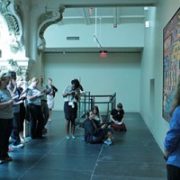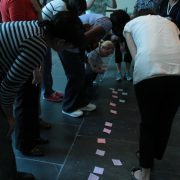Have you caught up on Smithsonian news in your neighborhood?
 Extra! Extra! Read all about it! The Fall 2013 issue of The Affiliate Newsletter just wrapped up production. In this issue:
Extra! Extra! Read all about it! The Fall 2013 issue of The Affiliate Newsletter just wrapped up production. In this issue:
West Coast Partner Brings SI to LA
Get a peek at several Smithsonian collaborations at the Japanese American National Museum in Los Angeles that are helping to tell the American story through the Japanese story.

2013 conference attendees participated in hands-on workshops at ImagiNATIONS education space in the National Museum of the American Indian.
Connecting Communities, Classrooms, and Colleagues at the 2013 National Conference
A record-breaking 119 attendees from 74 Affiliates attended the 2013 Affiliations National Conference. Check out some conference photos and see what your Affiliate colleagues said about the meeting.
Hanging Out with Elvis in Fort Worth
Guest author Amy Henderson, cultural historian at the National Portrait Gallery, shares her experience visiting Fort Worth Museum of Science and History while the Elvis at 21 exhibition was on display.
Smithsonian EdLab Shares New Twist to Digital Learning
Smithsonian EdLab workshops at four Affiliates demonstrated the power of going beyond the walls of the classroom to create a 21st-century idea of what education can be.
Announcing the I. Michael Heyman Smithsonian Across America Fund
We’re announcing a new fund to support the work of Smithsonian Affiliations in sharing resources with people in their own communities.
2013 Intern Partners and Visiting Professionals
Quick highlights from our four Affiliate staff members and one Affiliate intern during their residencies at the Smithsonian.

Ed Nichols, History Colorado director, and Harold Closter, Smithsonian Affiliations director view Jefferson’s Bible before it is displayed at History Colorado (Denver).
A Conversation with History Colorado
Five questions with History Colorado about the impact of bringing Thomas Jefferson’s Bible to the Denver community.
Smithsonian In Your Neighborhood
A recap of events, exhibitions and programs in Affiliate neighborhoods from May to October 2013.
Visit our ISSUU library for past editions of The Affiliate Newsletter.
















